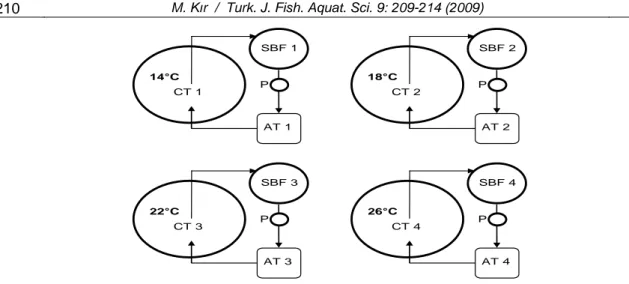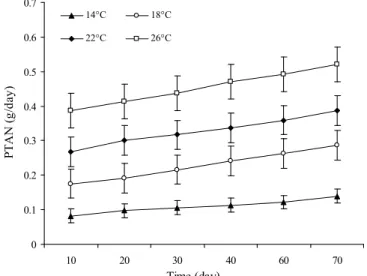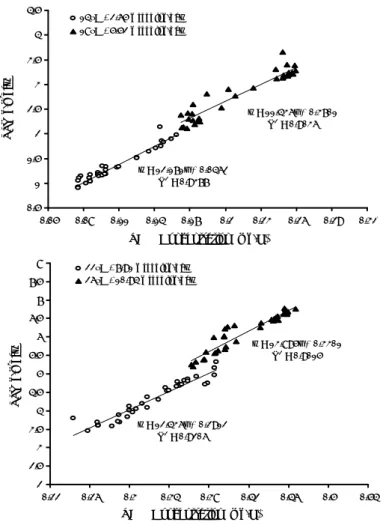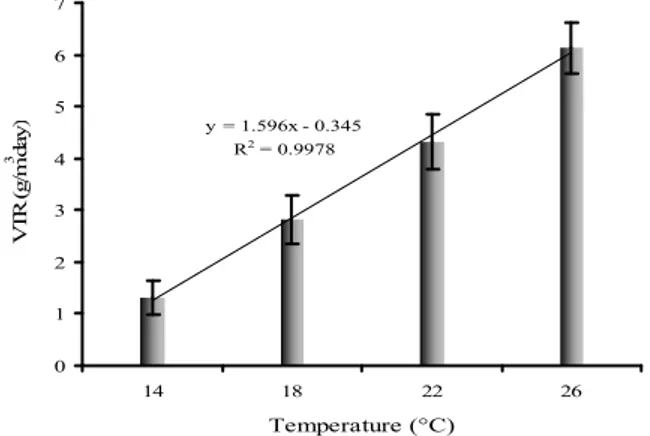© Central Fisheries Research Institute (CFRI) Trabzon, Turkey and Japan International Cooperation Agency (JICA)
Nitrification Performance of a Submerged Biofilter in a Laboratory Scale
Size of the Recirculating Shrimp System
Introduction
The shrimp farming industry can benefit significantly from improved water management regimes. Recirculating aquaculture farms support high densities of fish and shellfish with high production efficiency while minimizing water usage and environmental impact (Preston et al., 1997). Ammonia removal is a key process for the efficient use and reuse of water in recirculating aquaculture systems (Losordo and Wester, 1994).
Biological filters are widely used in aquaculture systems to remove ammonia and nitrite from culture water. A biofilter is a fixed film reactor in which only the active biomass on the filter medium is responsible for bio-oxidation of substrates, regardless of the total present in biofilm.. Fixed film reactors are an appropriate technology for use in an industry where good water quality is a secondary objective to the production of large quantities of crustaceans (Malone and Pfeiffer, 2005). Different types of biofilm reactors have been used for the biological treatment of water in recirculating aquaculture systems. For example, the submerged filter operates as a high-rate biological and mechanical filter in the same reactor and the biofilm is always submerged in water (Gomez et al., 2003). These filters are used mainly in lightly loaded systems such as display aquaria or crab shedding systems. They have, however, also been utilized in a variety of formats for recirculating shrimp production systems that are more heavily loaded (Davis and Arnold, 1998; Tseng et al., 1998).
In a biofilter, bacterial growth and the nitrification rate of the biofilm are affected by
different variables, including ammonia concentration, organic loading, dissolved oxygen, pH value, temperature, and salinity. Water temperature and ammonia influence nitrification processes, thus they are the most important variables for biofilter design and operation (Zhu and Chen, 1999). Significant research concerning the effects of these variables on the biofiltration systems of recirculating aquaculture systems has been conducted (Fdz-Polanco et al., 1994; Groeneweg et al., 1994; Hanaki et al., 1990; Hao and Huang, 1996; Tseng et al., 1996). Comparative studies (Fdz-Polanco et al., 1994; Tseng and Wu, 2004; Brazil, 2006) have shown that nitrification performance varies among different types of biofilters. The objectives of this study were to determine the effects of water temperature and ammonia concentration on the efficiency of ammonia removal by a submerged biofilter in a recirculating shrimp aquaculture system.
Materials and Methods
Recirculating Aquaculture Systems
The experiments were conducted over 70 days at four different water temperatures (14°C, 18°C, 22°C, and 26°C) in four different recirculating systems, all with the same features (Figure 1). Each experiment which was conducted each water temperature were replicated at different times for statistical evaluation of filter. All recirculating aquaculture system consisted of a circular polypropylene culture tank
Mehmet Kır1,*
1 Mugla University, Faculty of Fisheries, 48000 Kotekli, Mugla, Turkey.
Corresponding Author: Tel.: +90 252 2111896; Fax: +090. 252 2238475; E-mail: mkir@mu.edu.tr
Received 15 November 2008 Accepted 30 May 2009
Abstract
A submerged biofilter (SBF) with 0.1 m3 of filter medium was maintained without backwash at four different water
temperatures (14°C, 18°C, 22°C, and 26°C) in four different recirculating systems stocked with green tiger shrimp (Penaeus
semisulcatus). The ammonia removal profile and nitrification performance of the SBF was evaluated at feed loading rates of
2.65 g day-1 at 14°C, 5.52 g day-1 at 18°C, 7.91 g day-1 at 22°C, and 10.94 g day-1 at 26°C In all of the experimental systems,
the ammonia removal rate per unit volume of filter medium (the volumetric total ammonia nitrogen conversion rate, VTR) increased at the start of the experiment, reached and maintained a maximum value for a period of time, then decreased sharply. Statistical analysis revealed significant relationships among water temperature, total ammonia nitrogen (TAN), and the VTR. Temperature was not more important than TAN when comparing their effects on the VTR of the SBF.
(CT) (ø 90 cm, water volume 350 L), a submerged biofilter (SBF) (with 0.1 m3 of bioball filter medium),
an aeration tank (AT), and a pump. The water volume of each system was approximately 500 L. As shown Figure 1, effluent seawater from each CT flowed through the SBF by gravity to remove ammonia and nitrite. After aeration, treated water flowed into the CT. Flow rate of each system was 1.2 L min-1.
The water entered the CT in a direction parallel to the tank wall. The water flowed out of the tank through a suction pipe (3.0 cm diameter) situated with one end at the center bottom of the tank and the other directed to just above the surface of the water. In the CT, aeration was not permitted in order to prevent solids from being broken into smaller particles. The oxygen demand of shrimp was provided by the influent water through the AT. To control water temperatures, each CT was fitted with a 300–600 W submerged aquarium heater.
Shrimp Stocking and Feeding
Each tank was stocked initially with 30 green tiger shrimp, Penaeus semisulcatus (mean weight 20.61±0.31g). An extruded feed (ø 4mm) containing 45% crude protein (Pınar A.Ş., Izmir, Turkey) was offered to the shrimp during the experiment. The shrimp were carefully fed four times daily (at 06:00, 12:00, 18:00, and 24:00 hours) to visual satiation. To follow good feeding practice and to avoid the possibility of inter-worker error, satiation feeding was conducted at precise times by the same person throughout the experimental period. The mean feed consumption rates of shrimp at different water temperatures were calculated every 10 days by recording daily feed loading to the systems.
Total ammonia production (PTAN), which is
based on the shrimp feeding rate, was calculated using the following equation (Timmons et al., 2001; Pfeiffer and Malone, 2006): 092 . 0 × × =F PC PTAN (1)
where PTAN is total ammonia production (g day-1), F
is the daily feed ration in grams (g), PC is the percent crude protein of the feed, and 0.092 is a constant in the equation derived from a series of estimates formulated from the percent nitrogen in protein and the protein assimilation (1 day-1).
Water Sampling
Water was sampled from the systems daily to measure pH, dissolved oxygen, and temperature. pH was measured using a pH 315i meter (WTW Co., Weilheim, Germany). Dissolved oxygen and temperature were measured with a YSI 85 model hand held meter (YSI Inc., OH, USA).
To obtain the apparent nitrification performance of the biofilter, water sampled from the influent and effluent of each biofilter initially was analyzed every two days. Total ammonia nitrogen (TAN) was determined with a 4050 UV/visible Ultraspec II brand spectrometer (Biochrom Ltd., Cambridge, UK) by the phenate method at 640 nm (Parsons et al., 1985).
Ammonia Removal Cycle of the Biofilter
The ammonia removal rate (NR, %) was used to determine the ammonia removal cycle of the biofilters. NR is defined as the percentage of total ammonia that is reduced after passing through the SBF. For each biofilter, the NR was calculated using following equation (Tseng and Wu, 2004):
(
)
[
−]
×100%= TANI TANE TANI
NR (2)
where TANI and TANE are the total ammonia
nitrogen (TAN, mg L-1) in the influent and effluent,
respectively. P CT 1 SBF 1 AT 1 14°C P CT 2 SBF 2 AT 2 18°C P CT 3 SBF 3 AT 3 22°C P CT 4 SBF 4 AT 4 26°C
Figure 1. Recirculating shrimp systems used in the experiment. CT: Culture tank, SBF: Submerged biofilter, AT: Aeration tank
The duration of the ammonia removal cycle was defined as the time until the biofilter collapsed, which is the point at which ammonia removal has increased to a stable condition. This value is determined according to the variation of NR with time.
Performance Analysis of the Biofilter
For each recirculating system and each feed loading rate, the volumetric total ammonia nitrogen conversion rate (VTR) was used as the principle indicator to evaluate the performance of the SBFs. For each biofilter, the VTR was calculated using following equation (Pfeiffer and Malone, 2006):
(
)
b r E I V Q TAN TAN VTR= − (3)where VTR is the volumetric total ammonia conversion rate (g m-3), TAN
I is the influent total
ammonia concentration (g m-3), TAN
E isthe effluent
total ammonia concentration (g m-3). Q
r is the flow
rate through the filter (m3 day-3), and V
b is the total
volume of the biofilter medium (m-3).
Statistical Analysis
Statistical analysis was performed using SPSS
14.0 statistical software. Data from each system were subjected to one-way ANOVA for PTAN and two-way
ANOVA for the VTR. Duncan’s multiple range tests was used to compare the mean values among treatments. Using the regression analysis function of Microsoft Excel, regression analyses were used to derive equations for VTR between TAN concentration and temperature.
Results and Discussion
System Water Quality
Table 1 shows water quality data and changes in feed loading for each system. The average daily feed loading was 2.65 g day-1 for the 14°C system; 5.52 g day-1 for the 18°C system; 7.91 g day-1 for the 22°C
system, and 10.94 g day-1 for the 26°C system. The
different feed loadings caused TAN production (PTAN)
to differ among the systems (Figure 2). Average PTAN
values were 0.10 mg L-1, 0.21 mg L-1, 0.32 mg L-1,
and 0.41 mg L-1 at the four different feed loading rates,
respectively. Statistical analysis indicated that temperature and feed loading rates had a significant effect on the PTAN,
and temperature also affected feed loading rates (P < 0.05). The feed consumption of shrimp and the mean PTAN were approximately four-fold greater at 26°C
versus 14°C.
Table 1. Mean (± standard deviation) water quality data measured from the systems
Daily feed rates (g day-1)
2.65 5.52 7.91 10.94 DO (mg L-1) 8.2 ± 0.05 7.2 ± 0.19 7.1 ± 0.13 6.8 ± 0.37 pH 8.16 ± 0.05 8.09 ± 0.09 8.02 ± 0.11 7.94 ± 0.12 TAN (mg L-1) 0.10 ± 0.024 0.19 ± 0.025 0.28 ± 0.026 0.36 ± 0.021 NO2-N(mg L-1) 0.014 ± 0.005 0.016 ± 0.004 0.023 ± 0.012 0.032 ± 0.018 0 0.1 0.2 0.3 0.4 0.5 0.6 0.7 10 20 30 40 60 70 Time (day) PT AN ( g/ da y) 14°C 18°C 22°C 26°C
Figure 2. Total ammonia production (PTAN) at different water temperatures and feed loading rates. o O
-r-t--+/
r-1-/1
r
+---+-1----1---1
t---
r-r/+/r--I
f---f---f---!---+---I
Temperature effected water quality by increasing feed loading rate. TAN values measured at different systems are 0.10 mg L-1, 0.19 mg L-1, 0.28 mg L-1, and 0.36 mg L -1 respectively. It is also determined that the differences
between average PTAN and TAN values measured were
increased with increasing temperature. It means that temperature effect not only the feed loading rate so water quality but also activation of nitrifiying bacteria. Therefore the water quality of the recirculating systems was stable throughout the experiment; there were no water quality problems for either the shrimp or the bacteria in the SBF. Acceptable levels of TAN and NO2-
occurred in each system. pH levels of all system were above 7.0 throughout the trial. The concentrations of dissolved oxygen in the influent of the CT ranged from 6.8 to 8.2 mg L-1, and the dissolved oxygen
concentrations in each tank remained above 5.0 mg L -1. During the experiment, dissolved oxygen levels of
the water in all of the SBFs were maintained above 2 mg L-1 level, which is considered necessary for
satisfactory filter performance.
Biofilter Nitrification Performance
Figure 3 shows the relationship between the
VTR and TAN concentration at different water temperatures. In this study, TAN concentration significantly affected the VTR (P < 0.05). The VTRs of biofilters were positively effected by TAN and temperature in a linear manner. Statistical analysis showed that temperature, ammonia concentration, and the interaction between them significantly affected nitrification performance (P < 0.05); as the TAN concentration increased, a proportional improvement in the conversion ability of biofilters occurred. Similar results have beenreported for other types of biofilter (Rogers and Klemetson, 1985; DeLosReyes and Lawson, 1996; Malone et al., 1999; Sandu et al., 2002). Others have shown that the specific growth rate of nitrifying bacteria and the ammonia removal rate of the biofilm increase as the ammonia level increases (Paller, 1992; Zhu and Chen, 1999).
The relationship between temperature and VTR is shown in Figure 4. The impact of temperature on nitrification performance due to dissolved oxygen limitation is different from that due to TAN limitation. When oxygen is limited, the decrease in saturation of dissolved oxygen as temperature increases results in a negative temperature impact on the nitrification rate (Tseng and Wu, 2004). In our
y = 12.171x + 0.0462 R2 = 0.9377 y = 11.436x + 0.3701 R2 = 0.9036 0.5 1 1.5 2 2.5 3 3.5 4 4.5 0.05 0.08 0.11 0.14 0.17 0.2 0.23 0.26 0.29 0.32 TAN Concentration (mg/L) VT R ( g/ m 3 da y) 14°C - 2.65 g feeding/day 18°C - 5.52 g feeding/day y = 12.436x + 0.2912 R2 = 0.9206 y = 13.895x + 0.3301 R2 = 0.9015 2 2.5 3 3.5 4 4.5 5 5.5 6 6.5 7 7.5 8 0.22 0.26 0.3 0.34 0.38 0.42 0.46 0.5 0.54 TAN Concentration (mg/L) VT R ( g/ m 3 da y) 22°C - 7.91 g feeding/day 26°C - 10.94 g feeding/day
Figure 3. Relationship between VTR and TAN concentration at 14 °C, 18°C, 22 °C and 26 °C (y= VTR , x= TAN).
o
•
o
•
study, it was difficult to address the effect of temperature on the nitrification performance of the fixed film because this bioprocess is influenced by other temperature-dependent phenomena and parameters, including substrate diffusion and transport and dissolved oxygen concentration (Fdz-Polanco et al., 1994).
The current results clearly show that temperature was not more important that TAN when comparing their effects on the VTR of the SBF Numerous other studies have indicated that variable temperatures usually have little effect on the performance of biofilters, except at extreme (and mainly lower) temperatures (Haug and McCarty, 1972; Harremoes, 1982; Fdz-Polanco et al., 1994).
Ammonia Removal Cycle
Regardless of the experimental conditions used, the four SBFs showed similar trends in the ammonia removal cycle: The ammonia removal rate rose slowly but steadily until it reached a stable state, at which point an abrupt decrease occurred, indicating the
collapse of the biofilm. The ammonia removal cycles were 67 days, 63 days, 52 days, and 38 days at 14°C, 18°C, 22°C and 26°C, respectively (Figure 5). The SBF removed approximately 26.8% of the TAN from the 14°C system and 23.53%, 19.87%, and 14.91% from the 18°C, 22°C, and 26°C systems, respectively. Although the ammonia removal rate (NR %) decreased with increasing temperature (Figure 4), the actual amount of TAN removed by the SBF increased with increasing temperature (Figure 3). Temperature had a significant effect on NR (P < 0.05). The activity of microorganisms responsible for the bio-oxidation of ammonia increases with temperature in the normal temperature range (Shammas, 1986). Wortman and Wheaton (1991) also found a linear relationship between the ammonia removal rate and temperature at 7–35°C. In addition, increased temperature causes an increase in the unionized ammonia level in the TAN content (Groeneweg et al., 1994; Kır et al., 2004; Kır and Kumlu, 2006). Previous reports and our own results show that an increase in temperature results in greater ammonia removal and growth of nitrifying
y = 1.596x - 0.345 R2 = 0.9978 0 1 2 3 4 5 6 7 14 18 22 26 Temperature (°C) VT R ( g/ m 3 da y)
Figure 4. Relationship between VTR and water temperature (y= VTR , x= water temperature).
0 5 10 15 20 25 30 35 40 45 0 5 10 15 20 25 30 35 40 45 50 55 60 65 70 75 Time (day) A m m oni a r em ova l r at e ( % 14°C - 2.65 g feeding/day 18°C - 5.52 g feeding/day 22°C - 7.91 g feeding/day 26°C - 10.94 g feeding/day
Figure 5. The ammonia removal rates (NR%) of SBF varied over time (days) at 14 °C, 18 °C, 22 °C and 26 °C.
bacteria. In turn, this decreases the time required for the biofilm to reach the critical active thickness and the duration of the ammonia removal cycle. Furthermore, the duration of the ammonia cycle of an SBF is affected by influent water temperature and the TAN concentration.
References
Brazil, B.L. 2006. Performance and operation of a rotating biological contactor in a tilapia recirculating aquaculture system. Aquacult. Eng., 34: 261–274. Colt, J., Lamoureux, J., Patterson, R. and Rogers, G. 2006.
Reporting satandarts for biofilter performance studies. Aquacult. Eng. 34: 377–388.
Davis, D.A., Arnold, C.R., 1998. The design, management and production of a recirculating raceway system for the production of marine shrimp. Aquacult. Eng., 17: 193–211.
DeLosReyes Jr., A.A. and Lawson, T.B. 1996. Combination of a bead filter and rotating biological contactor in a recirculating fish culture system. Aquacult. Eng., 15: 27–39.
Fdz-Polanco, F., Garcia, P. and Villaverde, S. 1994. Temperature effect on nitrifying bacteria activity in biofilters: activation and free ammonia inhibition. Wat. Sci. Technol. 30(11): 121–130.
Gomez, M.A., Galvez J.M., Hontorıa, E. and Lopez, J.G. 2003. Influence of ethanol concentration on biofilm bacterial composition from a denitrifying submerged fitler used for contaminated groundwater. Journal Of Bioscience And Bioengineering, 95(3): 245–251. Groeneweg, J., Sellner, B. and Tappe, W. 1994. Ammonia
oxidation in Nitrosomonas at NH3 concentrations near
Km: effects of pH and temperature. Water Res.. 28: 2561–2566.
Hanaki, K., Wantawin, C. and Ohgaki, S. 1990. Effects of the activity of heterotrophs on nitrification in a suspended-growth reactor. Water Res. 24, 289–296. Hao, O.J. and Huang, J. 1996. Alternation aerobic-anoxic
process for nitrogen removal: process evaluation. Water Environ. Res., 68: 83–93.
Harremoes, P. 1982. Criteria for nitrification in fixed film reactors. Water Sci. Technol., 14: 167–187.
Haug, R.T. and McCarty, P.L. 1972. Nitrification with submerged filters. J. Water Pollut. Control Fed., 44: 2086–2102.
Kır, M., Kumlu, M. and Eroldoğan, O.T. 2004. Effect of temperature on acute toxicity of ammonia to Penaeus semisulcatus juveniles, Aquaculture, 241: 479-489 Kır, M. and Kumlu, M. 2006. Acute toxicity of ammonia to
Penaeus semisulcatus post-larvae in relation to
salinity Journal of the World Aquaculture Society, 37: (2): 231-235
Losordo, T.M. and Westers, H. 1994. System carrying capacity and flow estimation. In: M.B. Timmons, and T.M. Losordo (Eds.), Aquaculture Water Reuse Systems: Engineering Design and Management.
Elsevier, 9–60
Malone, R.F., Beecher, L.E. and De Los Reyes Jr, A. 1999. Sizing and management of floating bead bioclarifiers. In: Aquaculture Engineering and Waste Management, Proceedings from the Aquaculture Exposition VIII and Aquaculture Mid-Atlantic Conference, June 24– 28 Washington, DC: 256–267.
Malone, R.F. and Pfeiffer, T. 2005. Rating fixed film nitrifiying biofilters used in recirculating aquaculture systems. Aquacult. Eng., 34: 389–402.
Paller, M.H. 1992. An analytical model for predicting the carrying capacity of submerged biofilters used in aquaculture. J. Appl. Aquacult., 1: 1–25.
Parsons, T.R., Maita, Y. and Lalli, C.M. 1985. A manual of chemical and biological methods for seawater analysis, Pergamon Press Oxford, 173 pp.
Pfeiffer, T. and Malone, R. 2006. Nitrification performance of a propeller-washed bead clarifier supporting a fluidized sand biofilter in a recirculating warmwater fish system. Aquacult. Eng., 34: 311–321.
Preston, N., Macleod, L., Rothlisberg, P. and Long, B. 1997. Environmentally sustainable aquaculture production - an Australian perspective. In: D.A. Hancock, D.C. Smith, A. Grant, J.P. Beumer, (Eds.), Proceedings of Developing and Sustaining World Fisheries Resources, 2nd World Fisheries Congress,
Australia: 471–477.
Rogers, G.L. and Klemetson, S.L. 1985. Ammonia removal in selected aquaculture water reuse biofilters. Aquaculture Engineering, 144: 86-89.
Sandu, S.I., Boardman, G.D., Watten, B.J. and Brazil, B.L. 2002. Factors influencing the nitrification efficiency of fluidized bed filter with a plastic medium. Aquacult. Eng., 26: 41–60.
Shammas, N.K. 1986. Interactions of temperature, pH and biomass on the nitrification process. J. Water Pollut. Control Fed., 58: 52–59.
Timmons, M.B., Ebeling, J.M., Wheaton, F.W., Summerfelt, S.T. and Vinci, B.J. 2001. Recirculating Aquaculture Systems. Cayuga Aqua Ventures, Ithaca, NY0-9712646-0-0.
Tseng, K.F., Chiou, J.H., Shyu, C.Z., Chou, S.C. and Liao, I.C. 1996. Effects of pH value and hydraulic retention time on ammonia removal efficiency of a submerged biofilter in a recirculating eel culture system. J. Fish. Soc. Taiwan, 23: 323–333.
Tseng, K.F., Su, H.M. and Su, M.S. 1998. Culture of
Penaeus monodon in a recirculating system. Aquacult.
Eng., 17: 138–147.
Tseng, K.F. and Wu K.L. 2004. The ammonia removal cycle for submerged biofilter used in a recirculating eel culture system. Aquacult. Eng., 31: 17–30. Wortman, B.F. and Wheaton, F. 1991. Temperature effects
on biodrum nitrification, Aquacult. Eng. 10: 183–205. Zhu, S. and Chen, S. 1999. An experimental study on
nitrification biofilm performances using a series reactor system. Aquacult. Eng., 20: 245–259.
View publication stats View publication stats



